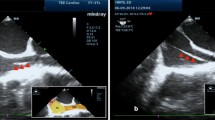Summary
The usefulness of transesophageal echocardiography (TEE) for guiding the placement of a pulmonary artery (PA) catheter was evaluated in 31 patients (TEE group); 31 patients who were treated before TEE guidance was used (control group). In the control group, use of the PA catheter was abandoned in two patients; because of an unstable condition and marked arrhythmias, respectively. The key findings for TEE guidance were: (1) pulsatile to-and-fro movement of the balloon, i.e., “shuttle movement” and (2) loss of shuttle movement at wedging of the balloon, i.e., “anchoring sign.” When the PA catheter did not enter the right vertricle (RV), the balloon was found to be in the inferior vena cava or the right atrium (RA) without shuttle movement. Coiling of the catheter was suggested in the latter situation. Coiling also occurred in the RV, often associated with frequent arrhythmias. These findings indicate that the catheter should be withdrawn once. TEE allowed for readjustment of the catheter tip position by enabling the balloon to be wedged twice. An excessively deep placement of the catheter tip was seen in 5 of the controls, but in none of the TEE group. Biplane TEE was found to be advantageous for guiding PA catheter placement and for visualizing the RV inflow and outflow tract in a single view, with the shuttle movement of the balloon in its long axis. TEE acts as an “eye” in the operating room, as does fluoroscopy, enabling smooth placement of the PA catheter.
Similar content being viewed by others
References
Oka Y, Orihashi K (1992) Right ventricular inflow tract. In: Oka Y, Goldiner PL (eds) Transesophageal echocardiography. JB Lippincott, Philadelphia, pp 237–257
Orihashi K, Goldiner PL (1992) Pulmonary artery. In: Oka Y, Goldiner PL (eds). Transesophageal echocardiography. JB Lippincott, Philadelphia, pp 259–264
Stone JG, Khambatta HJ, McDaniel DD (1983) Catheter-induced pulmonary artery trauma: Can it always be averted? J Thorac Cardiovasc Surg 86:146–155
Hardy JF, Morissette M, Taillefer J, Vauclair R (1985) Pathophysiology of rupture of the pulmonary artery by pulmonary artery balloon-tipped catheters. Anesth Analg 62:925–930
Yoshizato T, Hagler DJ (1989) Pulmonary artery catheter placement with two-dimensional echocardiographic guidance: A technique applicable in critically ill neonates. Mayo Clin Proc 64:387–391
Tuggle DW, Pryor R, Ward K, Tunell WP (1987) Realtime echocardiography: A new technique to facilitates Swan-Ganz catheter insertion. J Pediatr Surg 22:1169–1170
Turnage WS, Fontanet H (1993) Transesophageal echocardiography-guided pulmonary artery catheter placement. Anesth Analg 77:858–859
Daily EK, Tilkian AG (1986) Hemodynamic monitoring. In: Tilkian AG, Daily EK (eds) Cardiovascular procedures: Diagnostic techniques and therapeutic procedures. CV Mosby, St Louis, pp 83–116
Orihashi K, Oka Y (1992) Cannulae. In: Oka Y, Goldiner PL (eds) Transesophageal echocardiography. JB Lippincott, Philadelphia, pp 313–324
Black IW, Cranney GB, Walsh WF, Brender D (1992) Embolization of a left atrial ball thrombus during transesophageal echocardiography. J Am Soc Echocardiogr 5:271–273
Author information
Authors and Affiliations
Rights and permissions
About this article
Cite this article
Orihashi, K., Nakashima, Y., Sueda, T. et al. Usefulness of transesophageal echocardiography for guiding pulmonary artery catheter placement in the operating room. Heart Vessels 9, 315–321 (1994). https://doi.org/10.1007/BF01745097
Received:
Revised:
Accepted:
Issue Date:
DOI: https://doi.org/10.1007/BF01745097




